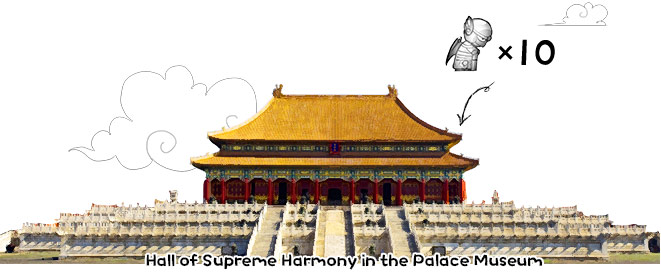-
Hangshi
Shaped like a divine monkey holding a treasure, with wings on its back, this beast appears only on the eaves of the Hall of Supreme Harmony (Taihe dian). Its real name is unknown, but since it occupies the tenth position, it’s called hangshi, meaning “ranked tenth.” Legend goes that it is the embodiment of Leizhenzi (a legendary figure mastering thunder) and can prevent lightning and fires.
-
Douniu
A dragon-like creature with a bull’s head and a scaly body, douniu is said to summon clouds, dispel mist, and bring rain to extinguish disasters.
-
Xiezhi
A mythical beast representing loyalty and justice,xiezhi was also a symbol of law and order in ancient China. With a single horn, it is said to be able to distinguish between right and wrong: When it encounters a dispute, it uses its horn to strike down those in the wrong.
-
Suanni
A fierce beast resembling a lion with a flowing mane,suanni is said to be one of the nine sons of the dragon, possessing the ability to devour tigers and leopards.
-
Yayu
An auspicious beast from the sea, covered in scales with a fish-like tail,yayu is believed to control rain and prevent fires. The character yain its name implies authority, as it is the leader of aquatic creatures.
-
Haima
A marine beast that resembles a horse, haima (meaning “sea horse”) is believed to dive into the depths and turn calamities into blessings.
-
Tianma
A celestial steed and a friend of dragons, tianma (meaning “heavenly horse”) is similar tohaima but has wings, allowing it to cover a thousand miles a day, chasing the wind and the sun.
-
Lion
As the king of beasts, the lion’s powerful and majestic presence makes it a fitting guardian for palace halls.
-
Phoenix
The phoenix, the king of all birds, is a symbol of harmony and auspiciousness. When the male (feng) and female (huang) fly together, they represent peace, prosperity, and favourable weather.
-
Dragon
In ancient times, the dragon was a totem of clan societies; in the imperial era, it became the emblem of the imperial family. Today, it symbolises the Chinese nation. Admired for its majestic form and auspicious meanings, the dragon holds a special place in people’s hearts.
-
Immortal Riding a Phoenix
This immortal is believed to be the embodiment of King Min of Qi (300–284 BCE) from the Warring States Period (475–221 BCE). After his defeat, he was pursued by enemies, and as he faced capture, a phoenix appeared from the heaven. Then King Min escaped on the phoenix’s back. Perched on the roof’s edge, the Immortal Riding a Phoenix symbolises miraculous escapes from the jaws of death and the transformation of danger into safety.
These ten creatures, along with the Immortal Riding a Phoenix, adorn the ridges of the Hall of Supreme Harmony. The number of these figurines varies with the building’s rank, with the Hall of Supreme Harmony—the largest hall in the Forbidden City—being the only building that allowed ten beasts. Other buildings can have a maximum of nine, while lower-ranked structures may feature just one.

Beneath their beautiful appearance lies a hidden function. Each beast conceals a sharp iron spike that secures the glazed tiles to the roof, while the figurines themselves protect the spikes from weathering, serving both aesthetic and practical purposes.
Chinese palaces, traditionally built from wood, are vulnerable to lightning and fires. These deftly designed beasts, each with unique powers, not only enhance the palace’s majesty but also carry the wishes for rain, fire prevention, and disaster elimination, turning ill luck into good. For hundreds of years, these enchanting figurines, like spirits, have stood watch over the palace faithfully and endured changing dynasties and the test of time, forming a unique, timeless view atop the eaves of ancient Chinese architecture.